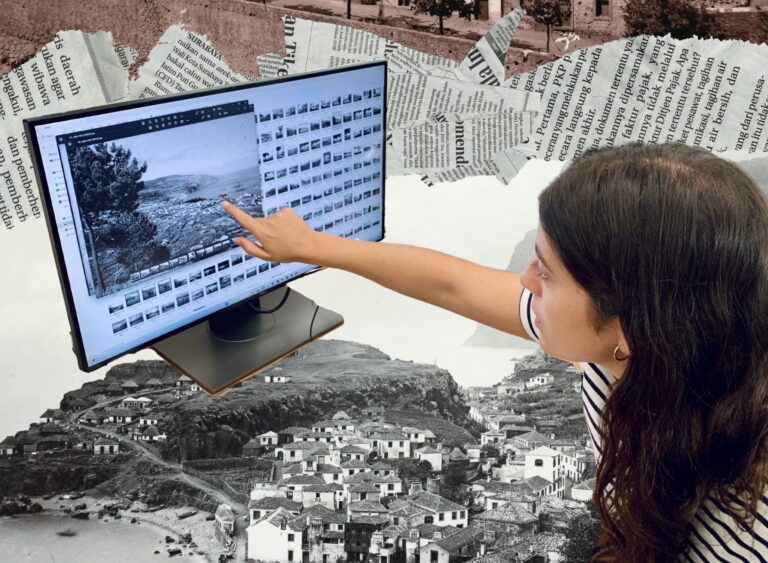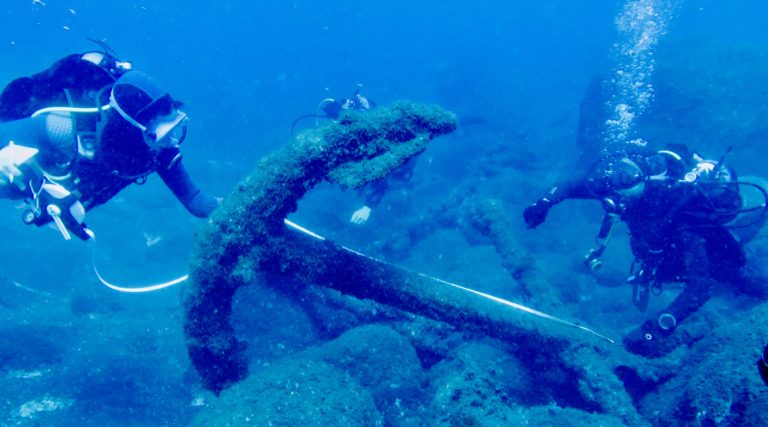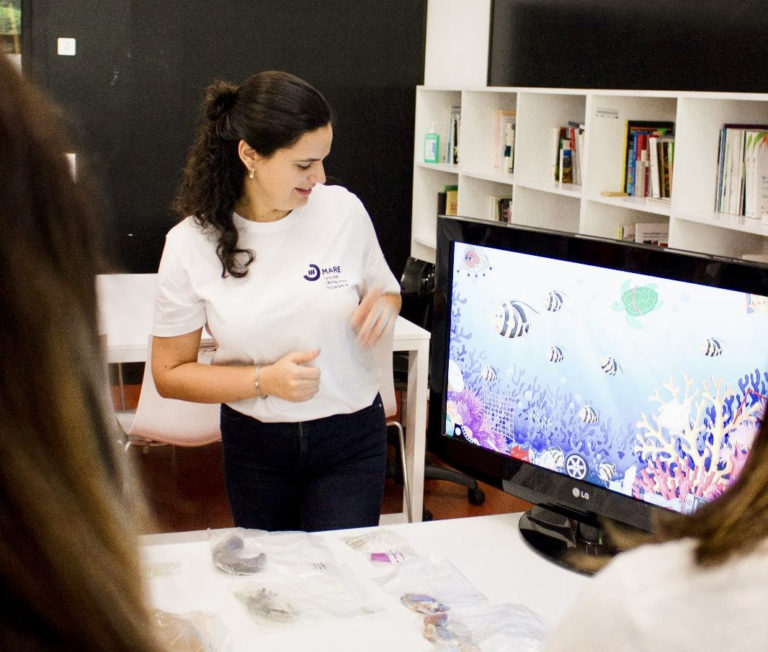Aquaculture in the Atlantic
An interview with Dr. Carlos Andrade
Madeira pioneered open ocean aquaculture in the 1990s. Learning from early aquaculture projects around Europe and adapting those processes and equipment for the harsher conditions of the Atlantic Ocean, Carlos Andrade and his team in the Fisheries Directorate of Madeira set up an aquaculture pilot project in 1995. Following this feasibility trial, offshore aquaculture has continued to grow around Madeira; these days, around 900 tons of fish are produced here every year.
Carlos is one of the more recent additions to MARE-Madeira and our leadership team. A principal investigator within our Ecosystem Services and Blue Economy team, Carlos is now dedicating his time to researching ways to improve the sustainability and circularity of aquaculture in Madeira.
In this interview, you’ll get an insider’s look at aquaculture in the open ocean, the challenges to doing aquaculture well, the value aquaculture brings to Madeira and Europe, and the uncertain future of limpets. (Lapas lovers beware the invasive algae now on our shores!)

When did you get into aquaculture and how did it start here?
After studying marine biology at the University of Lisbon, I wanted to do something in aquaculture. By chance, I saw an advert for a Master’s programme in Aquatic Resource Management at King’s College, London. When I finished and returned to the island, I started working in the Fisheries Directorate, where I began figuring out the possibilities for aquaculture here.
Following methodologies from the UN’s Food and Agriculture Organization (FAO), I did a survey, looked at the infrastructure of the island and reviewed previous aquaculture experiences in the area, like the Forest Department’s experiment in the 1950’s with trout in Ribeira Frio or the long-held practice of keeping live bait for fishing. I did a cost analysis, showing that the ocean would be more cost effective than land, then I reviewed the species that were possible to rear at that time. I wrote a report with all my findings and shared it with the government.
After this, I organized a seminar in Madeira – inviting experts from different parts of the world and from different parts of aquaculture, from industry and academia. We had experts from the National Fisheries Institute, experts in maritime planning from the Faculty of Sciences at Lisbon, experts from the University of Stirling and University of Cork, and some colleagues from the Canaries who were also just starting in aquaculture. I shared my report with them and the experts more or less confirmed what we had concluded. In that meeting, we created a memorandum of tasks to do to develop aquaculture here.
What was it like, starting out?
It was a big adventure. We were creating a farm to produce 100 tons of fish in 1996. We’d never done this before. Purchasing juveniles, rearing them, trying to sell them – and to do this in a government department? (Laughs) It was a tremendous adventure.
It was also very risky. In the early 90’s, there was farming in the fjords of Norway and lochs in Scotland and sea bream was farmed in very calm places in the Mediterranean, but we didn’t see any open-ocean farms at that time. There were a lot of extra risks to consider.

How did you end up choosing the species to farm?
I’d made a list of all the fish from Madeira in my report. The problem was, none of those fish had ever been farmed – anywhere. Doing a pilot project in a very open environment at sea and having little experience of offshore fish farming – well, it was too risky to do that and bring in a species that no-one knew how to produce. So we selected gilthead-sea bream. Sea bream had already been farmed in the Mediterranean, so it was known and it had strong financial prospects.
What are the challenges to open ocean farming?
You have to consider right from the start that you’re dealing with a very harsh environment. The saltwater is corrosive, the waves are rough, at least for part of the year. You’re working on floating equipment which makes it risky for the people working there. You’re dealing with conditions and failures in equipment. Some parts of the year you can’t access the cages to feed the fish. You’re concerned for the welfare of the fish all the time. It’s a very tough business and demands a lot from the people working there. Fortunately, I had the chance to work with really fine workers during my time there, and that made a big difference.
Was there any resistance to starting aquaculture here?
Back then? None at all. I had the best comments, in general, from the public and government. It was only years later, when the aquaculture companies tried to put cages out in Porto de Sol that there were comments against aquaculture and people protesting.
What’s your understanding of the main concerns against aquaculture?
It’s such a mix. Some people are against farming. Some people are against the fact that a private company is using the sea (because by that time the government had leased its aquaculture operations to a private company), which is common ground. I think we need to make sure we’re talking more – all the stakeholders of the sea – so we can better address the concerns and reduce the impacts, but also not criminalize those who are doing aquaculture (or for that matter fishing, shipping, tourism and other ocean-related activities) well.

What are the biggest opportunities in aquaculture from here?
We’ve got these big ideas to bring more sustainability to aquaculture and to reduce its carbon footprint. We need to be more autonomous, more local. Reducing our dependence on imports (like the food and the juvenile fish) would be a big win. We should also move to growing local species, this is the other big thing. We’ve been doing an effort in the last few years to find new species that can replace sea bream.
Finally, we’re trying to find species of low trophic levels to incorporate into our aquaculture program. That’s part of the research we’re doing at the moment. We’re looking at limpets and sea urchins and have managed to close the cycle in our studies. Now we’re increasing production and doing complementary studies.
What can the rest of the world learn from Madeira’s aquaculture efforts?

We’re one of the few regions doing production in oligotrophic waters. This means there’s no primary production to support bivalves, like oysters and mussels. It would be great if we could grow bivalves because they’re being used everywhere and the techniques are available and easy to adapt and there are markets for it. But we can’t do that – we don’t have the productivity or the commercial spaces for it. So we’re looking for grazers like limpets or urchins. We’re hoping that putting them in areas close to the fish farms, where it’s a little more productive and macroalgae can grow, will allow us to create a multi-trophic system for Madeira. Our trials in this area could help make open ocean aquaculture more circular in other regions, too.
What’s your perspective on the future of aquaculture and why it’s important?
We need to feed people. Simply put, we don’t have sufficient food resources here. The world is changing so fast and as people have better incomes, they’re going to buy more seafood. This pattern has happened everywhere. Millions of people are changing their food habits, especially in Asia, which means we’re competing for food. And are we producing enough seafood in Europe? No, we’re not. 70% of the seafood we consume is imported.
What are the other solutions to this, beyond aquaculture?
Better wild fishing practices will help. 75% of wild fishing stocks are on the verge of no recovery or at the top of exploitation. There’s lots to be done with regards to better stock management – the Norweigens did that with cod fish, letting it recover in the North Sea. We’ve done it with sardines in Portugal. But the environment has a carrying capacity – there’s a limit to what you can recover.
So we can also improve waste management. There’s a lot of discards going on. Fish that aren’t the target of the industry are thrown overboard. It’s forbidden by the EU but it’s still going on. We could also work to change the habits of people, to eat fewer carnivorous fish and fish that aren’t being overfished. This isn’t an easy task, but pricing will help, chefs preparing more herbivorous species will help.
We should look at all this. There’s no formula. Aquaculture isn’t the only way to get more fish. But it shows that it can balance the equation, take pressure off wild fishing and bring more fish to the table. And real efforts are being done to make it more sustainable.
Why did you come back to science?
I wanted to experiment more – with different species, with how to close the cycle. I wanted to do something new, come up with something new and learn more. That’s what science is, after all – finding new ways to look at the nature around you and figure out how it works.
What are you researching now?
To have a more circular aquaculture system, which integrates species from different trophic levels, we need to know more about these species’ lifecycles and ecology. We’re going back to the basics, really. And I must say, I’m getting more and more curious about things.
We did experiments with the two common species of limpets here. We asked ourselves: how come the white limpets produce the gametes before the reproduction occurs? What’s the trigger for that? How do they know they’re releasing gametes at the right time? We found out there’s a particular algae here that covers the rocks by the sea and that limpets can only reproduce in the presence of this coraline algae. If coraline algae isn’t there, the larvae won’t settle and metamorphosize to juveniles. So it’s not just the biology of the limpet – the algae also plays a role.

Limpet larvae & Lapas, a traditional Madeirense dish
Now we’re studying algae and trying to figure out what this algae is all about! We’ve learned that there’s a close association between these species. The coraline algae needs space on rocks to grow and it can’t grow if there’s other algae there. And what do limpets do? Limpets clean the rock so this algae can grow. It’s fantastic, isn’t it?
Does that mean the limpets are in trouble with the new invasive algae on Madeira’s shores?*
It’s bad news, yes. This algae seems to grow anywhere. We don’t know if the coraline algae here will interfere with its growth. Coraline algae produces chemicals that deters the growth of some algae on top of it, but we don’t know if it will work with this one. If it doesn’t, the brown algae will grow on top of the coraline algae… It’s something we need to be very aware of. I don’t know what’s going to happen.
*If you missed this news story and want to learn more about Rugulopteryx okamurae, the brown macroalgae that’s come to Madeira and is one of the most threatening invasive macroalgaes in Europe, check out our paper here: https://www.reabic.net/journals/bir/2022/4/BIR_2022_Bernal-Ibanez_etal.pdf



